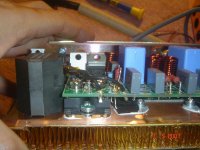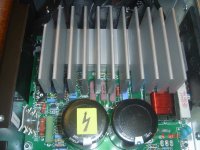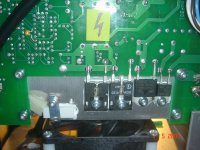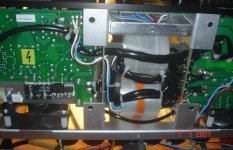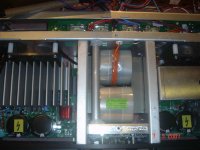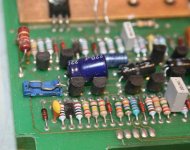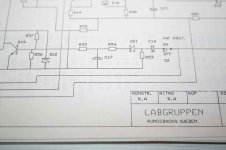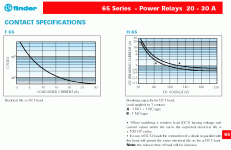See that 15A TO220 triac on the last picture?
Is a crowbar protection from output to ground…
Strongly recommend that you found another kind of protection.
In case of catastrophic failure, the loudspeakers and triac will probably burn…
Is a crowbar protection from output to ground…
Strongly recommend that you found another kind of protection.
In case of catastrophic failure, the loudspeakers and triac will probably burn…
TOINO
Flyback SMPS works at 27kHz according to LAB2000 sch. In the new fP+ series it’s properly higher as workhorse says – I only own one and have seen it on the factory. I will ask again are these amplifier made for music which has crest factor of around 10-12dB or a bench test with sinusoidal test signal?
Exactly – no current limiter can be seen from the amplifiers point of view!
In pro amps enemy number one is heat – this is a good way of dissipating the heat do you agree?
Simply look at the picture blue sw and look at sch. I will ask again who needs 3kW above 15kHz or even 1kW? This feature is implemented in all of their amps.
When I look at the LAB2000 sch it looks exactly like that - just simplified. I know the new fP+ series has self-osc circuit at the high and low side class D stages a la UcD instead of the fix 830kHz osc in fP6400.
I will ask again music or bench? Which amp has most power at 85% of normal mains voltage? Which voltage level do you think is available at open air live concert?
Don’t you worry I have been living with this crowbar circuit since 1987 in 100’s of amps.
Would you replace it with a relay? How fast do you think it reacts?
It is a flyback working slightly above 20KHz and its is why it needs a big transformer.The IGBTs are heavily current limited each cycle. Otherwise it doesn’t sustain the colossal primary current without immediate failure.The supply is regulated and in the case of the picture posted by Workhorse could sustain only one channel at specified full power 1kHz-4ohm for one or two seconds.
Flyback SMPS works at 27kHz according to LAB2000 sch. In the new fP+ series it’s properly higher as workhorse says – I only own one and have seen it on the factory. I will ask again are these amplifier made for music which has crest factor of around 10-12dB or a bench test with sinusoidal test signal?
The only advantage I could see in this power supply is that is naturally short circuit proof. I mean: in the short circuit the only components in stress are the output rectifiers, electrolytics and secondary wires. This is inherent to all flyback psu.
Exactly – no current limiter can be seen from the amplifiers point of view!
About the dissipator:It is simply an automobile motor thermal radiator. I have seen it for the first time in my car, and second time in an old H/H British amplifier.
In pro amps enemy number one is heat – this is a good way of dissipating the heat do you agree?
About the 15KHz protection: The amplifier mutes at this frequencies simply because the tracking power supply doesn’t follows the signal… it is not fast enough.( mute or die)
Simply look at the picture blue sw and look at sch. I will ask again who needs 3kW above 15kHz or even 1kW? This feature is implemented in all of their amps.
This is the patent: http://www.pat2pdf.org/patents/pat5200711.pdf but the implementation is more like this:
When I look at the LAB2000 sch it looks exactly like that - just simplified. I know the new fP+ series has self-osc circuit at the high and low side class D stages a la UcD instead of the fix 830kHz osc in fP6400.
About the power announced (10Kw)
Let me laugh… The size of buck converter coils on the picture, tells everything. The output power is highly policed. No chance on big concert subbass boxes compared with “traditional monsters” like Crown VZ5000 (near some announced per channel power).
About the power chord for 10KW amplifier: 16amp regular European home appliance.
I will ask again music or bench? Which amp has most power at 85% of normal mains voltage? Which voltage level do you think is available at open air live concert?
See that 15A TO220 triac on the last picture?
Is a crowbar protection from output to ground…
Strongly recommend that you found another kind of protection.
In case of catastrophic failure, the loudspeakers and triac will probably burn…
Don’t you worry I have been living with this crowbar circuit since 1987 in 100’s of amps.
Would you replace it with a relay? How fast do you think it reacts?
Attachments
Hi Robert GS
I could agree with you about the “music or bench” question; obviously music.
About your suggestion of regulated power supply superiority in live concert, I cannot. If the mains voltage supply is deficient, the amplifier supply compensates consuming more current, lowering even more the mains voltage. The situation could be much worse, tripping the protection circuits and collapsing the mains. From where are they getting the energy?
They are not miracles here and the amplifier could not “invent” power. The regulated supply is not a power generating device.
The only way is good and stable mains supply, but I admit that regulation is a good thing for the internal amplifier power circuits. However my measurements show obvious current limiting on the supply. They are in fact an adjust resistor for that propose.
I suppose you have the Lab2000 schematic? Please take a closer look, because the tracking supply is regular quartz drive triangle carrier, both channels synchronized. However their patent 5200711 is self-oscillating…and I like the concept.
The problem with this Crowbar circuit is not their reaction speed, but their destruction speed… how could a 15A device stop all the accumulated energy on those big capacitors? Do you know the price of concert loudspeakers?
Really nobody needs 1KW above 15KHz but the manufacturer claims or suggests that capability. The fact is that the amplifier could not work in that conditions and survive.
Well… the “Intercooler Cooling System” stuff …I cannot forget that is simply like my car heat radiator. Only difference is that my car sustains full power for more than 2 seconds without thermal protect!
Must confess that I will never be used with that kind of publicity.
And finally this little insult to our intelligence: a 10Kw amplifier with a 16A power cord it is just too ridiculous…😕
I could agree with you about the “music or bench” question; obviously music.
About your suggestion of regulated power supply superiority in live concert, I cannot. If the mains voltage supply is deficient, the amplifier supply compensates consuming more current, lowering even more the mains voltage. The situation could be much worse, tripping the protection circuits and collapsing the mains. From where are they getting the energy?
They are not miracles here and the amplifier could not “invent” power. The regulated supply is not a power generating device.
The only way is good and stable mains supply, but I admit that regulation is a good thing for the internal amplifier power circuits. However my measurements show obvious current limiting on the supply. They are in fact an adjust resistor for that propose.
I suppose you have the Lab2000 schematic? Please take a closer look, because the tracking supply is regular quartz drive triangle carrier, both channels synchronized. However their patent 5200711 is self-oscillating…and I like the concept.
The problem with this Crowbar circuit is not their reaction speed, but their destruction speed… how could a 15A device stop all the accumulated energy on those big capacitors? Do you know the price of concert loudspeakers?
Really nobody needs 1KW above 15KHz but the manufacturer claims or suggests that capability. The fact is that the amplifier could not work in that conditions and survive.
Well… the “Intercooler Cooling System” stuff …I cannot forget that is simply like my car heat radiator. Only difference is that my car sustains full power for more than 2 seconds without thermal protect!
Must confess that I will never be used with that kind of publicity.
And finally this little insult to our intelligence: a 10Kw amplifier with a 16A power cord it is just too ridiculous…😕
TOINO
Often at open air they bring their own diesel generators and they aren’t as stabile as you would like. Even the mains isn’t as stabile as you would like – I have had to redesigning one of my PSU because of a mains voltage of 200V at a costumers outlet, which should have been 230V!
Quote from the text of the patent and have a look at schematic: A square wave generator 205 delivers a square wave having a frequency chosen between 200kHz and 2MHz….
No self-osc in the earlier Class TD only the new generation fP+.
I have too admit that I’m not sure of the sound quality of the new generation – haven’t had the opportunity for a real test – gigs and time didn’t allow this. This part of my activities has less priority – now it's my own development and DIY product that counts.
There are a lot of insults around, but how would you specify it => 16A * 230V = 3680W???, then all amplifiers connected via 16A cord is 3680W get real. I think the new fP+ has 20A mains current limiting, but… It’s still music we are talking - please accept this. Please calculate: 10000W – 10dB and then there is even power let over for heat generation internally! This is called practical engineering.
About your suggestion of regulated power supply superiority in live concert, I cannot. If the mains voltage supply is deficient, the amplifier supply compensates consuming more current, lowering even more the mains voltage. The situation could be much worse, tripping the protection circuits and collapsing the mains. From where are they getting the energy?
Often at open air they bring their own diesel generators and they aren’t as stabile as you would like. Even the mains isn’t as stabile as you would like – I have had to redesigning one of my PSU because of a mains voltage of 200V at a costumers outlet, which should have been 230V!
I suppose you have the Lab2000 schematic? Please take a closer look, because the tracking supply is regular quartz drive triangle carrier, both channels synchronized. However their patent 5200711 is self-oscillating…and I like the concept.
Quote from the text of the patent and have a look at schematic: A square wave generator 205 delivers a square wave having a frequency chosen between 200kHz and 2MHz….
No self-osc in the earlier Class TD only the new generation fP+.
I have too admit that I’m not sure of the sound quality of the new generation – haven’t had the opportunity for a real test – gigs and time didn’t allow this. This part of my activities has less priority – now it's my own development and DIY product that counts.
And finally this little insult to our intelligence: a 10Kw amplifier with a 16A power cord it is just too ridiculous…
There are a lot of insults around, but how would you specify it => 16A * 230V = 3680W???, then all amplifiers connected via 16A cord is 3680W get real. I think the new fP+ has 20A mains current limiting, but… It’s still music we are talking - please accept this. Please calculate: 10000W – 10dB and then there is even power let over for heat generation internally! This is called practical engineering.
There is nothing wrong with the triac crowbar approach as long as the triac and the related PCB traces are sized to exhibit a somewhat higher i^2t product than the rail fuses. A short to a 150V supply rail (4 ohms load) is likely to cause 40A to flow and relay contacts just arc and burn and stick together in these circumstances, relays are only practical for AC or low power (or low voltage) DC applications like the usual 100Wpc hi-fi stuff (or 12V switching in cars).
Also, there is nothing wrong with an amplifier capable of 5KW peak but sized to output just 1000W average per channel. Furthermore, a protection system preventing the amplifier from delivering more than 1000W average per channel is a very good thing, because in live performances you will usually attach two 15 inch or 18 inch LF speakers rated at 600W rms each (or a single one rated at 1000W rms) to each channel, and they become inherently protected from long-term overpowering that way. Due to the extremely dynamic nature of (live) music signals (as opposed to the compressed junk that we find in CDs intended for loudness in low-power hi-fi), the high power figures discussed here are only required during very brief periods of time.
That's practical engineering, but it's quite hard to teach such a subject here, even engineering seems hard to teach when people is thinking in smoke coming out of a circuit rather than considering i^2t products...
Concerning relay DC blocking performance, the following graph shows what we can expect at best... just 0.8A blocking at 150V from any high quality 30A device 😀😀😀
Also, there is nothing wrong with an amplifier capable of 5KW peak but sized to output just 1000W average per channel. Furthermore, a protection system preventing the amplifier from delivering more than 1000W average per channel is a very good thing, because in live performances you will usually attach two 15 inch or 18 inch LF speakers rated at 600W rms each (or a single one rated at 1000W rms) to each channel, and they become inherently protected from long-term overpowering that way. Due to the extremely dynamic nature of (live) music signals (as opposed to the compressed junk that we find in CDs intended for loudness in low-power hi-fi), the high power figures discussed here are only required during very brief periods of time.
That's practical engineering, but it's quite hard to teach such a subject here, even engineering seems hard to teach when people is thinking in smoke coming out of a circuit rather than considering i^2t products...
Concerning relay DC blocking performance, the following graph shows what we can expect at best... just 0.8A blocking at 150V from any high quality 30A device 😀😀😀
Attachments
Folks.
I could easily agree with some of the arguments about the real necessary power for concert music, except maybe on the sub-bass stuff.
But what really annoys me is the loss of relation between the advertised and reality.
Practical engineering has nothing to do with ethics?
FP10000Q claims 2100W at 4ohm (hopefully they don’t advertise Wrms as no such thing exists) all 4 ch.s driven.
What on earth is that supposed to mean?
Sorry EVA but is everything wrong when you sell “an amplifier capable of 5KW peak but sized to output just 1000W average” advertising the peak power as if it is average, independently of all good practical engineering inside.
They are standards for this kind of peak and average measurements.
My own experience with this amplifier crowbar circuit in particular, is burned triacs and burned loudspeakers…
Guess why? They are no means to stop the PSU when you have DC on the output.
So the triac short circuits and the regulated PSU pumps even more current on it until (if) some fuse goes down.
The solution is good practical engineering and you could found it here, for example:
http://www.meyersound.com/pdf/products/legacy/ms-1000a.pdf
Page 68 we have scr1 and scr2 who could disconnect the supply (before capacitors). On Switched PSU is even simpler…
On next page, active rail discharge…
Yes, I know that those things costs money… and some producers prefer spend it in advertising “Intercooler” stuff.
I thought about ignoring it, and I tried hard, but sorry… I can’t.
Now you push me to feel like the small child in The Emperor's New Clothes tale
http://hca.gilead.org.il/emperor.html
I could easily agree with some of the arguments about the real necessary power for concert music, except maybe on the sub-bass stuff.
But what really annoys me is the loss of relation between the advertised and reality.
Practical engineering has nothing to do with ethics?
FP10000Q claims 2100W at 4ohm (hopefully they don’t advertise Wrms as no such thing exists) all 4 ch.s driven.
What on earth is that supposed to mean?
Sorry EVA but is everything wrong when you sell “an amplifier capable of 5KW peak but sized to output just 1000W average” advertising the peak power as if it is average, independently of all good practical engineering inside.
They are standards for this kind of peak and average measurements.
My own experience with this amplifier crowbar circuit in particular, is burned triacs and burned loudspeakers…
Guess why? They are no means to stop the PSU when you have DC on the output.
So the triac short circuits and the regulated PSU pumps even more current on it until (if) some fuse goes down.
The solution is good practical engineering and you could found it here, for example:
http://www.meyersound.com/pdf/products/legacy/ms-1000a.pdf
Page 68 we have scr1 and scr2 who could disconnect the supply (before capacitors). On Switched PSU is even simpler…
On next page, active rail discharge…
Yes, I know that those things costs money… and some producers prefer spend it in advertising “Intercooler” stuff.
I thought about ignoring it, and I tried hard, but sorry… I can’t.
Now you push me to feel like the small child in The Emperor's New Clothes tale
http://hca.gilead.org.il/emperor.html
Looking at the complexity and added cost of Class-TD, I think Class-D is still much better for high power audio and with advances in Semiconductor technology it is acting as good solution..
Hmm... 
What we need is a revolution on loudspeaker driver technology.
Don’t forget that more than 90% of the amplifier power is lost in heat.
Enclose a modern hi power bass loudspeaker is the equivalent to put a dry iron (http://en.wikipedia.org/wiki/Ironing) in a closed box. 😀 😀 😀

What we need is a revolution on loudspeaker driver technology.
Don’t forget that more than 90% of the amplifier power is lost in heat.
Enclose a modern hi power bass loudspeaker is the equivalent to put a dry iron (http://en.wikipedia.org/wiki/Ironing) in a closed box. 😀 😀 😀
Toino,
A simple Question....Whats your profession man......I think you could change the things very much indeed....😉
Kanwar
A simple Question....Whats your profession man......I think you could change the things very much indeed....😉
Kanwar
What we need is a revolution on loudspeaker driver technology.
What about changeing the laws of physics ??? 😉 😀
Regards
Charles
- Status
- Not open for further replies.
- Home
- Amplifiers
- Solid State
- LabGruppen, what to do?
